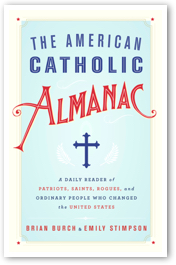The American Catholic Almanac
- BRIAN BURCH AND EMILY STIMPSON
Brian Burch and Emily Stimpson have put together a page-a-day history of 365 inspiring stories celebrating the historic contributions of American men and women who have been shaped by their Catholic faith.
January 1: The Little Girl from Cork
 Early on the morning of January 1, 1892, as the J. E. Moore Barge approached its destination, eleven-year-old Anthony Moore and his seven-year-old brother Phillip knew nothing about what their new life in America would hold. The brothers did know, though, that it was their sister Annie's fifteenth birthday and, with a little teamwork, they could help her become the first immigrant to set foot on the newly opened Ellis Island.
Early on the morning of January 1, 1892, as the J. E. Moore Barge approached its destination, eleven-year-old Anthony Moore and his seven-year-old brother Phillip knew nothing about what their new life in America would hold. The brothers did know, though, that it was their sister Annie's fifteenth birthday and, with a little teamwork, they could help her become the first immigrant to set foot on the newly opened Ellis Island.
Twelve days earlier, the three young Catholics had boarded the steamship Nevada in Queenstown (County Cork, Ireland). Along with 145 other steerage passengers, the Moores spent Christmas in the ship's crowded belly. Finally, late on December 31, they arrived in New York Harbor.
The next morning, the Nevada's steerage passengers disembarked and boarded a barge bound for Ellis Island. There, immigrants would undergo a medical and legal inspection before being cleared for entry into the country.
It was on the barge that the Moore brothers concocted their plan. Enlisting the help of a chivalrous Irishman (who bellowed, "Ladies first!"), they blocked the path of a large German and pushed their sister onto the gangplank. The girl half ran and half tripped across the dock, receiving a $10 gold piece from the Immigration Bureau upon her arrival.
After the fanfare subsided, the siblings were reunited with their parents, who lived in a Manhattan tenement. Annie eventually married a German bakery clerk and bore him 11 children. She died in 1924 at the age of 47.
Today, a bronze statue of the little Catholic girl from County Cork — young, slim, and suitcase in hand — still stands on Ellis Island, an enduring symbol of the 12 million souls who passed through that particular portal between 1892 and 1954, as well as the countless others who arrived elsewhere after journeying across land and sea to make a new home for themselves in the United States of America.
January 2: A General Maligned
General James Longstreet was not popular with the Episcopalians in New Orleans. On Sundays, when the former Confederate commander entered his pew, his fellow worshippers routinely rose and walked out. To them, honoring God mattered less than dishonoring Longstreet.
It wasn't just the Episcopalians, however, who had it in for Longstreet. By 1877, most everyone in the former Confederate States of America loathed General Robert E. Lee's one-time second-in-command. Many blamed the South Carolina native for the Confederacy's devastating loss at Gettysburg and blamed him even more for his support of President Ulysses S. Grant's Republican Administration. The value of the services rendered by Longstreet — Lee's "Old War Horse" — at the Battles of Fredericksburg, Second Bull Run, Antietam, and Chickamauga, as well as in the Wilderness Campaign, was lost on his contemporaries. Or, at least, most of his contemporaries.
Hearing of the Episcopalians' scorn for Longstreet, Father Abram Ryan, a former Confederate chaplain, paid the general a visit.
Catholics, Father Ryan informed him, didn't care who worshipped in their midst, and if Longstreet ever decided to convert, they would welcome him with open arms. Longstreet took Ryan up on his offer. He entered the Catholic Church in 1877 and remained a devout communicant to the end of his life.
Over the course of the next 27 years, Longstreet would go on to serve his country as ambassador to the Ottoman Empire, a U.S. marshal, and U.S. railroad commissioner. History would clear Longstreet's reputation; he had adamantly opposed Lee's battle plan at Gettysburg, ordering the infamous Pickett's Charge only under protest. Longstreet had also been close friends with Grant since their days at West Point.
But Longstreet never lived long enough to see his good name restored in the South. He died of pneumonia on January 2, 1904, at the age of 82.
January 3: The Gladiator Bishop
Two million. That's how many Irishmen migrated to America in the wake of the Great Potato Famine of 1845. The majority passed through New York City, where many stayed.
With no money and little education, the immigrants crowded into tenements overrun by disease, crime, and poverty. In New York, anti-Irish and anti-Catholic sentiments rose.
The city's Irish, however, had a champion in Archbishop John Hughes.
Described by a contemporary as "more of a Roman gladiator than a follower of the meek founder of Christianity," Hughes himself immigrated to the United States from Ireland in 1817. A few years later, as a gardener at Mount St. Mary's Seminary, he so impressed the visiting Elizabeth Ann Seton that she convinced the seminary to admit him.
After his ordination in 1826, Hughes went to Philadelphia, which, at the time, was a hotbed of anti-Catholic nativism. Outspoken, forceful, and determined to prevent Catholics in America from becoming second-class citizens, Hughes routinely sparred with Nativist preachers, whom he called the "the clerical scum of the country."
Accordingly, by 1842, when Hughes became New York's fourth bishop, he was well seasoned for his role as champion of the Irish.
Hughes initiated the campaign for his flock by waging a legal battle against the Protestant monopoly of New York's educational system and founding more than 100 schools. He then invited the Society of St. Vincent de Paul and the Sisters of Mercy into his diocese, trusting them more than the state to care for the city's poor. He likewise promoted temperance pledges and devotion to the Sacred Heart, believing discipline and piety could overcome poverty and violence.
History proved him right. Within a generation, the moral squalor of the Irish slums was eradicated, and instead of composing the majority of the city's underclass, the Irish of New York composed a majority of the city's schoolteachers, policemen, and civic leaders.
Hughes died on January 3, 1864, 14 years after becoming New York's first archbishop.
January 4: The Independent Catholic Church of America
If not for an Irish Franciscan's loyalty to Rome, the Independent Catholic Church of America could have been established in 1819.
The trouble began years earlier, when, with the appointment of America's first bishop, John Carroll, Irish-American Catholics began demanding the right to hire and fire their own priests. As trustees of the churches they financed and built, they believed the right to choose the priests belonged to them. Following the death of Carroll's successor, Archbishop Leonard Neale, and the appointment of the Frenchman Ambrose Maréchal, as Archbishop of Baltimore, tensions rose even higher.
First, the Catholics of Newport, Virginia, sent a letter to Rome demanding the right to appoint their own clergymen. Then, on January 4, 1819, Catholics in Charleston, South Carolina, had Father Thomas Carbery of New York forward a letter for them to Father Hayes in Dublin.
The letter requested that the Franciscan priest travel "in the most secret manner" to the Netherlands, where a schismatic Jansenist bishop resided. It then instructed him to "have yourself consecrated Bishop of South Carolina."
The letter concluded with the promise that, "On your arrival in America your expenses shall be made good to you, but you must agree to consecrate other bishops in this country, otherwise your salary may be doubtful."
Alarmed, Hayes immediately had the letter translated into Italian, then sent it on to the Holy Father in Rome. Recognizing that schism loomed, the Vatican responded by creating new dioceses in Virginia and South Carolina, and sending two Irishmen to lead them: Patrick Kelly to Richmond and John England to Charleston.
Schism was averted, but the battle against what would come to be known as "trusteeism" was far from over.
January 5: America's Most Useful Citizen
By October of 1917, six months after America entered into the fray of World War I, Catholics constituted less than 17 percent of the country's population. Despite that, they accounted for 35 percent of new army recruits.
Credit for those numbers belonged largely to one man: Baltimore's Archbishop James Cardinal Gibbons.
The Baltimore-born, Irish-American prelate had served as a Union chaplain at Fort McHenry, Baltimore, during the American Civil War, and was almost as strong a believer in the United States and the virtue of patriotism as he was in the tenets of the Catholic Church.
That support was evident in April 1917, on the eve of Congress's declaration of war against Germany, when Gibbons issued the following statement to the press:
In the present emergency it behooves every American citizen to do his duty, and to uphold the hands of the President and the Legislative department in the solemn obligations that confront us. The primary duty of a citizen is loyalty to country. This loyalty is manifested more by acts than by words; by solemn service rather than by empty declaration. It is exhibited by an absolute and unreserved obedience to his country's call.
For his support of America's military in World War I — including initiating the founding of the National Catholic War Council (the forerunner to the United States Conference of Catholic Bishops), which coordinated spiritual, medical, and material support for U.S. troops — Gibbons earned nearly universal praise from top government officials.
No praise, however, touched that of former President Theodore Roosevelt, who, even before America entered the war, wrote to Gibbons on January 5, 1917, saying, "Taking your life as a whole, I think you now occupy the position of being the most respected and venerated and useful citizen in our country."
 This is Meaghen Gonzalez, Editor of CERC. I hope you appreciated this piece. We curate these articles especially for believers like you.
This is Meaghen Gonzalez, Editor of CERC. I hope you appreciated this piece. We curate these articles especially for believers like you.
Please show your appreciation by making a $3 donation. CERC is entirely reader supported.

Acknowledgement

 Brian Burch and Emily Stimpson. "January 1-5." The American Catholic Almanac. (New York: Image, 2014): 3-7.
Brian Burch and Emily Stimpson. "January 1-5." The American Catholic Almanac. (New York: Image, 2014): 3-7.
Excerpted by permission of Image Books, a division of Penguin Random House. All rights reserved. No part of this excerpt may be reproduced or reprinted without permission in writing from the publisher.
For more information, visit ImageCatholicBooks.com.
The Author

 Brian Burch is president of CatholicVote.org, a nonprofit political advocacy group based in Chicago.
Brian Burch is president of CatholicVote.org, a nonprofit political advocacy group based in Chicago.
Emily Stimpson is a freelance Catholic writer based in Steubenville, Ohio. She is a contributing editor to Our Sunday Visitor Newsweekly, a blogger for CatholicVote.com, and a columnist for Lay Witness. Her books include These Beautiful Bones: An Everyday Theology of the Body, and The Catholic Girl's Survival Guide for the Single Years.
Together Brian Burch and Emily Stimpson have written The American Catholic Almanac: A Daily Reader of Patriots, Saints, Rogues, and Ordinary People Who Changed the United States.
Copyright © 2014 Image Catholic Books



